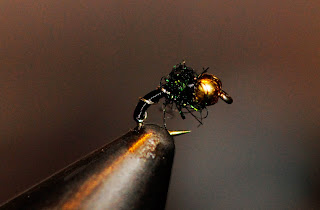I would like to follow up on my experiences at
Oktoberfisch (Oct. 18-20, 2013) this year. It was the first time that I was able to attend and I had a blast.
Oktoberfisch is put on by the
Fredricksburg Fly Fishers on the Llano River outside of Junction, TX.

Due to weather conditions I got up to Oktoberfisch and met up with the
Alamo Fly Fishers very early Saturday morning (I can't comment on any mischief before then). Temps were in the upper 30s when I arrived.....way to cold for a native central Texan as far as I am concerned. Needless to say I was in waders the whole trip....
Testicle numbing water aside....We killed a bit of time walking around the camp seeing old friends from other clubs and making new ones. As one of the local fishing gurus likes to put it...."Central Texas stream fish are very gentlemanly and don't wake up until after 10:00 am." This is true in a mid Texas summer and more so at the 30-40 degree temps we were experiencing.
So I took my time, go registered and examined my way through the tables of raffle items and booths. Throughout the day many different classes were going on. They ranged to from beginners casting an entomology crash course put on by Texas Parks and Wildlife. Beginners and more advanced tying courses were offered too. For myself the course in two handed techniques was a must....and I even had my "never got the chance to use it" switch rod with me. However, it was an afternoon class and the sun has warmed enough for me to loose a layer of clothing.
Gentlemanly fish might just be waking up.....
 |
| Bullys Blue Gill Spider |
So down the river my fishing buddy and I went. Kayaking the Llano during this event is very common, but we decided to wade it. Both of us are avid "perch jerkers" and find wading to be our most productive method to work a shore line. Its a game of numbers and only occasionally something of size shows up.
 |
| Rio Grander Cichlid |
We went up to the first road crossing from the park and worked our way down river for several hours. It was slow at first, but as temps rose fishing got better. Unexpectedly Texas Cichlids were the dominant catch for me. A couple species of sunfish snuck in to the mix too, but no bass for me
personally.
Time came to return for my class. The instructor discussed the techniques and various set ups on the demo rods he has for the students to try. I got to cast a "
Ballistic “ Vector” Series" from Ballistic Spey lines on what I think was a 9wt. The fly line functionally was a large shooting head with an integrated running line. It was a cannon....Definitely thinking about its possible jetty applications. The instructors transitioned over to working with individual students so I went and got my Cabelas LSi Switch rod (an 11 ft 7wt). I have this rod set up for Skagit style casting and Rio lines (ask on
Facebook if you want more details).
I walked up to the instructor and flat out said "I bought it on special and I don't know how to use it?"
The instructor said let me cast it and after a couple more details about how it was set up we were off and running. He showed me the basics and had me get into the water work through the casts.
Below is a a video after I had been a casting a while and it wasn't the best cast I made but it illustrates how much I got out this little course and the consensus was that all the coursed had results like I got.
After the class it was time to go cast some rods.....most of which are out of this poor grad students price range....so when else would I get to cast them.
The guys from
Living Waters Fly Fishing brought an assortment of rods out cast. The rod me and friend just HAD to cast was the Scott Fiberglass rod. The had the 2wt.......I felt like Tinkerbell casting it.....like waving a fairy wand. Don't get me wrong it could cast very well, but it was so light in the hand I would take me a while to get used to it.
The evening was concluded with a steak dinner and a raffle. I won a fly line in the raffle and there were rumors our table might have had the rowdiest bunch of guys there.....but I cannot confirm or deny such information.


Sunday morning was met with a mild hangover....good scotch does go with fly fishing.....
But no hangover shall eve keep me from fishing!
So we journeyed on the confluence of the Llano and James rivers to fish.

Again we waded through the waters.
This was good fishing.
I pulled 28 sunfish out of a single overhanging tree and just kept catching the further I waded.
Water clarity was pretty poor from recent rains so it was all about dark sinking flies.
The event as a whole would be a great way to bring new fly fishers in to the fold. Complete novices can learn from scratch and more advanced fisherman can pick up some new tips and tricks.




















































